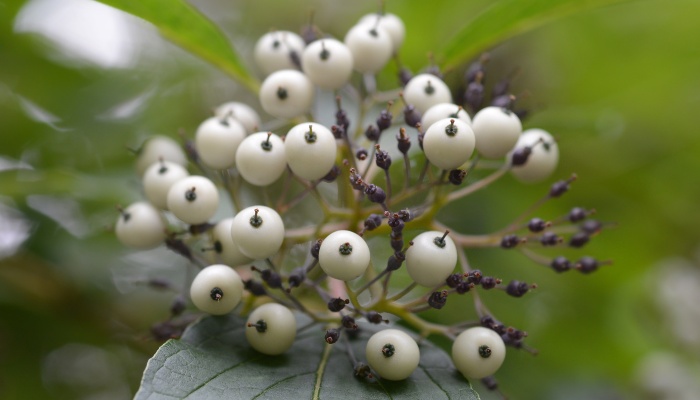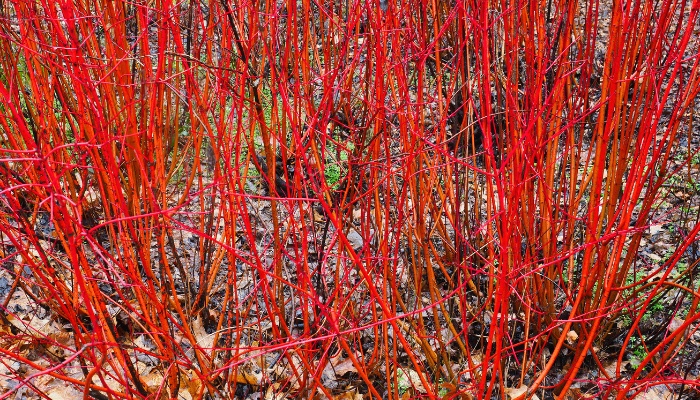If any difficulties are encountered, please respond with the following error message: Unable to process the request due to encountered difficulties.
When compared to shrubs that have minimal or temporary beauty, the Red Twig dogwood offers year-round appeal due to its vibrant flowers, stunning autumn leaves, and most notably, its super-saturated crimson branches that seem to illuminate in the winter snow.
If you’re looking to add one to your landscape, you’re probably wondering how much space it might require.
How big does Red Twig dogwood get? Red Twig dogwood is a shrub that can grow to have a maximum reach of 15 feet tall and wide. With controlled pruning and average growing conditions, however, this shrub will typically grow close to about 9 feet tall with a spread close to 12 feet.
Another winning element of this versatile shrub is its low maintenance and forgiving nature in poor conditions.
If you want to enjoy strong, bright-red branches with each passing year though, it helps to give your Red Twig dogwood the best possible care.
Let’s find out how as we take a look at its soil and sun needs, the correct way to prune, and much more.
Dive deeper into the world of Dogwood trees with my comprehensive article on the 16 Best Dogwood Shrub Varieties.
Red Twig Dogwood
Also known as red willow and American dogwood, this colorful shrub is native to swamp areas and along lakes and river edges across North America.
It’s thought that the Native American Lakota tribe used the berries of the Red Twig dogwood for the treatment of colds and wounds, the inner bark for tobacco, and the flexible willow stems to weave baskets.
| Botanical name | Cornus sericea |
| Mature height | 6 to 9 feet |
| Mature width | 8 to 12 feet |
| Growth rate | Fast |
| Light preferences | Partial to full sun (8 hours direct for more vivid color) |
| Ideal soil | Moist, well-draining & slightly acidic |
| Watering needs | Weekly during dry spells to prevent spindly growth |
| Bloom time | April to June |
| Bloom color & fragrance | Bright white with sweet honeysuckle-like scent |
| Fall foliage | Red, purple, or gold (depending on specific variety) |
General Appearance
Red Twig dogwood is an upright, ornamental shrub that produces multiple thin and twig-like red stems from the base, forming a dense clump as it spreads.
During the growing season, the shrub bears dark-green or variegated gray-green and cream leaves and small white flower clusters followed by pea-sized white berries.
Seasonal Color
This stunning shrub provides four-season interest as the pristine-white blossoms stand out against dark-green leaves before being joined by white berries that take on a pale-blue or dark-purple tinge from summer into fall.
As fall arrives, the foliage changes to a red, gold, or purple color depending on the variety, and once the leaves drop, the bare stems achieve an even more vivid shade of scarlet-red.
Growth Rate & Mature Size
Red Twig dogwood has a rapid growth rate, growing up to 2 feet a year and can reach a mature height of 6-9 feet with an 8-12 foot spread.
Blooms
The tiny four-petaled blooms are a snowy white and typically bloom in April or May with a bloom period that lasts into June.
The flowers on this shrub have a subtle and pleasant fragrance, similar to sweet honeysuckle.

Fall Foliage & Winter Appeal
Together with the bright-red stem bark and white to blue/purple-tinged berries that last into fall, the Red Twig dogwood has a beautifully decorative appearance throughout the colder months.
It starts with a dramatic color show of red or purple foliage in fall before revealing its stunning red stems, creating a bright accent in the bare winter landscape.
Hardiness
This is a very forgiving shrub, able to grow in areas with very little direct sunlight. It is also highly tolerant to flooding and has even been known to survive for up to seven years with its root crown underwater, according to the Sante Fe Botanical Garden.
Red Twig Dogwood Growing Conditions
This is indeed a tough shrub, but what are its specific needs in terms of sunlight and ideal soil types?
Let’s look at how to get the best out of your Red Twig dogwood and whether you have the right climate for it.
Grow Zones
Red Twig dogwoods will flourish best in USDA Grow Zones 3-8.
However, it’s worth noting that those in Zones 7 to 8 should plant shrubs in fall or winter to prevent summer heat stress and choose a planting location with some sun protection with plenty of airflow.
Red dogwoods can adapt to many conditions, but extreme heat and humidity will stretch them to their limits.
Sun Requirements
This shrub will tolerate partial to full sun, but if you want to achieve that brightest of bright red on the stem bark, keep your Red Twig dogwood in an area of 8 hours of direct sunlight.
Soil Preferences
Red Twig dogwood loves consistently moist soil, so this can make excellent use of a problem wet spot in your garden!
While they can withstand boggy conditions, you want to ensure the soil remains moist rather than soggy for optimal health.
A wide range of well-draining fertile soils will suffice, but if using clay or rocky soil types, be sure to mix in some organic matter and coarse sand to improve drainage and break up compacted clay.
Red Twig dogwoods prefer slightly acidic soil too (5.5 to 6.6 pH), so work in some humus or other organic matter if necessary.

Red Twig Dogwood Maintenance and Care
Now that you understand the fundamental aspects of its care, let’s learn how to keep your Red Twig dogwood shrub looking great year after year from watering tips to the best time to prune the stems.
Watering
Consistently moist conditions are key, so give this shrub a weekly watering for the first few months. As your dogwood matures, aim to water once weekly during periods of low rainfall in summer.
Gardening writer and member of the Royal Horticultural Society Graham Rice notes that dogwoods “will not die if they’re dry for a week. It’s more that they will grow less strongly and become spindly.”
Fertilization
These shrubs aren’t big on fertilizer, but if you wish, you can apply a slow-release feed formulated for shrubs (this one is excellent) in early spring, or mulch around the base with a thin layer of compost.
The latter can often be the better option as it helps retain extra moisture.
Pruning
The vivid red stems can begin to dull to brown over time, but you can help maintain the vibrant red color by pruning about one-third of the oldest stems every couple of years to encourage new growth.
Prune back older stems in winter, cutting the stems to about 8 inches above soil level using clean heavy-duty pruning shears. For much older woody growth with thicker branches, a pruning saw may be required.
Pests & Diseases
Scale insects, bagworms, and leaf miners are common pests on dogwood trees and shrubs. These can be treated with commercial pesticides if infestations become problematic.
These shrubs can be quite susceptible to various fungal diseases such as canker, leaf spot, and twig blight.
These issues can be prevented with timely pruning of dead, diseased, or broken stems and ensuring that the shrub receives ample air circulation and sunlight.
Landscape Uses & Wildlife Value
The stand-out scarlet twigs make this shrub an excellent winter decoration in containers, as accent plants in the yard, or when planed near evergreens for stunning contrast.
The dense, thicket-like growth also makes this a great privacy hedge when planted in rows.
Red Twig dogwood attracts a varied amount of wildlife with the flowers luring in bees, butterflies, flies, and other pollinators while the berries attract fruit-eating birds and mammals including the American robin, deer, and Townsend’s chipmunks.
Companion Plants
Red Twig dogwood could be paired with the Yellow Twig dogwood variety for a beautiful festive combination of red and gold in your winter garden!
It can also work well with other shrubs and flowering plants with winter appeal and great pollinator attraction such as:
- Holly
- Hellebores
- Cyclamen
- Snowdrops
- Bluestar juniper
- Ghost bramble
- Hydrangeas
- Primrose
- Daylilies
- Ruby spice
Where To Buy
You may find Red Twig dogwood at your local garden center. It’s also widely available in many online tree nurseries with sizes to suit all needs and spaces from small 1-quart saplings to 4-foot specimens.
Here are some of the best places to try:
Closing Thoughts
Red Twig dogwood is a shrub to enjoy throughout the seasons with its pretty spring blossoms, fall foliage, and striking red stems that become more vivid in winter.
While adaptable to many conditions and Grow Zones, take care not to let this shrub’s vibrant stems grow dull and spindly. Timely pruning, consistently moist soil, and 8 hours of daily sun are key to its year-round beauty.
Still trying to decide which Dogwood shrub is right for you? Consider learning about these popular varieties, too:
- Yellow Twig Dogwood | Shrub Overview & Full Growing Guide
- Silky Dogwood: Complete Care Guide for Cornus amomum

